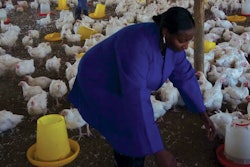
It’s often been said that success results from the combination of preparation and opportunity. The U.S. Grains Council (USGC) aims to put this concept into action for the commodities it represents, both by reinforcing existing strong relationships and by laying the groundwork needed to capitalize on opportunistic demand when it arises. For the U.S. sorghum industry, paying attention to short- and long-term demand — and taking advantage of favorable trade policies, value in the market and unique nutritional benefits — is leading to growing export potential in countries including South Africa, Pakistan and Peru.
South African drought creates need for feed grain imports
USGC positioned sorghum as an alternative feed grain for South Africa after a severe drought in 2015 and 2016 led the South African feed industry to need to import grain for the first time in recent years.
The United States had an ample supply of corn available at a reasonable price to meet this need, but lagging biotech approvals in South Africa limited possible exports into the country. As a result, USGC and its members responded quickly to demonstrate U.S. sorghum provided another high-quality option for addressing the South African domestic supply situation and the market’s constraints at that time.
First, USGC sent a team of staff and member delegations to South Africa in May 2016 to meet with key stakeholders, learn more about the market need and explore options for importing an alternative feed grain. Straight away, UGSC brought a team from one of the largest corn milling companies in South Africa to the United States in order to offer additional information about the U.S. grain handling system and quality standards. In the fall of 2016, USGC organized a second trade team of South African commercial grain traders and end users to showcase the 2016 U.S. sorghum harvest.
As a result of these outreach efforts, South African buyers purchased about 3.91 million bushels (almost 100,000 metric tons) of U.S. sorghum in 2015/2016. Yearto- date sales of U.S. sorghum in the 2016/2017 marketing year already total about 1.95 million bushels (49,500 metric tons) as of Feb. 23, 2017. These sales compare to the prior five-year average (2010/2011-2014/2015) of about 938,000 bushels (almost 24,000 metric tons).
While the drought in South Africa has subsided, and the country has implemented biotech approvals for U.S. corn, additional feed grain demand for U.S. exporters is likely to continue in the region. The Council’s work to engage local buyers and members in education about U.S. sorghum means buyers in Southern and Eastern Africa now recognize the grain as a quality option to meet their demand.
USGC demonstrates sorghum value to Pakistani buyers
Pakistan is an emerging market in South Asia with large growth potential due to an increasing population and rising middle class. As incomes gain, so does demand for high-quality protein sources and the grain needed to feed those animals.
Pakistan is a top rice exporter, but domestic production cannot meet this burgeoning demand. U.S. feed grains provide a cost-effective solution, which led to purchases of more than 8 million bushels (more than 240,000 metric tons) of U.S. sorghum last marketing year, the first such order in more than a decade.
Political and economic instability, however, complicate market activities in the country. As a result, USGC works with the Pakistani feed industry through the Council’s South Asia representative, Amit Sachdev. Additionally, the Council routinely invites buyers and end users to activities outside of Pakistan’s borders but still within the region. For example, USGC included Pakistani buyers in the December 2016 Asia Subcontinent Trade Exchange in Kathmandu, Nepal. The conference allowed U.S. sellers and regional buyers to meet face-to-face and discuss topics like the political effects on trade, supply and demand of global feed grains as well as the dynamics of the diverse feed industries in South Asia.
Through these interactions, USGC finds a way to make trade work for feed grains like U.S. sorghum, even when the logistics and politics prove complicated.
Refashioning old perceptions into potential sales
Favorable trade policies already exist for buyers in Peru to purchase U.S. sorghum, but USGC and its partner organizations have first had to dispel misperceptions and demonstrate the economic and nutritional benefit for the country’s livestock industry.
Thanks to the existing free trade agreement between the United States and Peru, importers can purchase U.S. sorghum without an import tariff, an immediate advantage against corn of any origin. Yet, experiences with sorghum with high tannin levels, which reduce the nutritional advantage of sorghum for livestock feed, left end users with a bitter taste.
Knowing this concern, the U.S. sorghum industry undertook a purposeful plant breeding shift to reduce tannin levels and maximize the nutrient digestibility of sorghum for livestock. Today, U.S. sorghum has little to no tannins. This provides a considerable advantage over sorghum from competitors like Argentina and Brazil.
Additionally, U.S. sorghum is less susceptible to breakage, contains fewer mycotoxins and has a longer shelf life in hot and humid conditions. As a result, sorghum isa cost-effective addition to rations, particularly for broiler chickens and laying hens, requiring only slight dietary adjustments that do not increase cost.
With all these factors combined, USGC staff and consultants estimate the Peruvian poultry industry would reduce input costs by an estimated $10 million if buyers there shifted 30% of feed consumption to U.S. sorghum.
USGC began work to detail these economic and nutritional advantages of U.S. sorghum during visits in 2016, building on those relationships at a conference held this winter in Lima. There, Dr. Carlos López, nutritionist and professor at the Autonomous University of Mexico, explained how to adjust the formulation of poultry diets to take full advantage of the nutritional qualities of sorghum.
Meeting attendees represented 95% of the Peruvian poultry industry as well as representatives from universities, trade, dairy and swine industries. This strong and varied interest among the feed industry in Peru lay the foundation for sales into this South American market.
Continuing to reach out where new markets call
Export successes in these markets not only increase yearly sales of U.S. sorghum, but also provide new footholds in these regions to further expand outreach efforts.
Through this preparation, the ability of USGC and its partners to position U.S. sorghum as a high-quality feed option when the opportunity arises will continue to provide positive results for U.S. agriculture.
















